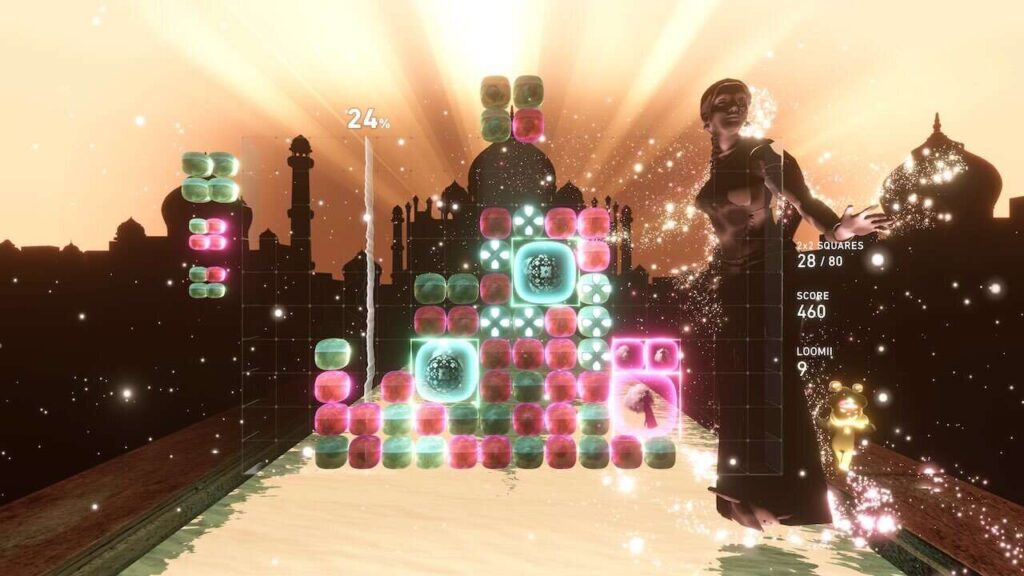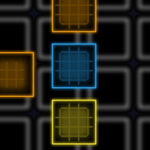Lumines Arise Review – A Victory for the Senses
Blog Andrew Joseph 11 Nov , 2025 0

As many video game studios continue to leverage technology in the pursuit of realism, developers Enhance and Monstars Inc. understand that technology can also be used in the pursuit of emotional impact. Their new game, Lumines Arise, lets you unleash your timeless creativity, bathing every inch of your screen in an array of mesmerizing visual effects. It builds on the series launched in 2004 and gives it the Tetris effect, delivering the same captivating and confident sensory experience.
Lumines have been largely dormant for the past decade. While Rise is a synaesthesia sequel, the core concepts of the hit series remain largely unchanged. You will still see a playing field divided into grids with 2×2 blocks falling from above. Each block consists of four squares, each painted in one of two colors or patterns. The goal is to drop blocks so that blocks of the same pattern touch each other to combine them into larger blocks of the same type – the bigger the block you combine, the more points you get.
All the while, the timeline (represented by a vertical line that moves from left to right to the beat of the music) sweeps away combined blocks when it comes into contact with them. So the key is to make a single type of blocks so that the timeline removes them and prevents the playing field from filling up, which is an instant game over, while also trying to make as many combinations of blocks as possible, either by scaling up existing blocks or creating multiple blocks at once. Your blocks will only score points as the timeline sweeps across, so it's a race against time and you have to create the biggest combination on each pass.

gallery
The series has always embodied an arcade spirit, but the atmosphere is influenced by prominent Tetris Effect influences. Think of each stage as its own little visual show, sometimes similar to the experience of watching fireworks, exploring an aquarium, or attending a concert, creating sets with lightning, particle effects, music, and background animations. Therefore, Lumines Arise is centered around the journey mode. The game consists of over 30 levels, each with unique themes, songs, and visual themes. It's still very arcade-y, with levels giving you points and being graded at the end. However, each stage has its own sensory capsule. You jump from dark, club-style levels, with frenzied electronica, and fast-paced music, to quieter, koi-swimming stages, and even though they're completely different, they all coexist—after all, you're still playing Lumines.
Even more impressively, Arise captures the tantalizing rush to get to the final level while maintaining the curiosity to explore what each stage has to offer. There's no way of knowing what's going to happen next, other than the small thumbnail on the stage selection menu. That tells you almost nothing, considering each level has its own visual gimmick, as well as at least one breakpoint that changes, affecting speed, music, visuals, or all of those elements.
However, reaching the final level is no easy task. Even for someone who has played Lumines before, I continued to hit roadblocks throughout. You can choose between three difficulty options, with higher options requiring more 2×2 blocks to clear the stage and generally increasing the speed at which blocks fall. Regardless, you most likely won't be able to complete the entire Journey mode without restarting the level multiple times. But I never felt depressed. Instead, I was forced to try again and see if I could beat my previous score. After a few days of gaming, I found that the satisfaction of my technological advancement had not diminished.
Part of this satisfaction is due to the burst mechanism. The percentage increases primarily as you build blocks, and when you're at least 50%, activating “Burst” will select a block on the playing field that hasn't been touched by the timeline and keep it in place for a few waves. During this time, the goal is to stack adjacent blocks of the same color to make the square larger. As you do this, blocks of the opposite color will be pushed upwards, and once you reach the final wave, the timeline will sweep over the blocks you've been building, which will all fall at once to fill the newly created empty space during the burst, creating another opportunity to clear the playing field. It took me a while to learn when to best utilize this mechanic, but once it works, creating blocks with over 200 blocks always makes me smile.

The background accompanies the experience with creative imagery – from silhouettes dancing under the rain to a group of people partying on the beach at sunset – but I’m always surprised to see that the neighborhoods and squares themselves change as well. Some looked completely different, including the apple and lime levels, which later became peppers and broccoli. Other times, you might build blocks out of little eggs, and once the timeline passes, they break and release little birds that start walking on top of the block.
The soundtrack, while appropriate for each level, isn't all that memorable. There are plenty of songs with vocal tracks, but sometimes it feels like an unnecessary attempt to do more while sacrificing rhythm – especially when the lyrics aren't very strong. That being said, I appreciate Arise working hard to create its own identity. Some levels are more zen-like, but many of them want you to move. Among them, hip-hop and a rather intense technical level stand out, and the intention to provide variety is clear.
“Arise” is gorgeous, but the visuals take away from how easy it is for you to read the action. Sometimes, there's just too much going on on the screen – especially in one level where the bottom of the playing field starts to fill with water, which looks great in motion but blurs readability. Thankfully, there are countless accessibility options that allow you to adjust the background opacity, zoom level, and other visual elements of your playfield. (There are also options to make the game easier.)
However, most of my complaints about visibility disappear when playing in virtual reality, since your perspective is closer to the playing field by default. As much as I enjoy playing the game at 144 fps on PC, Arise really shines in VR. Viewing visual animations and effects from a distance on a flat screen (which serves as a cool background for your game) is much different than viewing them closer to your eyes, while also magnifying the size of everything. The action of having to turn your head to see the entire background completes the synergy of all existing elements – playing on PlayStation 5 and PSVR2, the experience is mesmerizing.
The DualSense controller adds another layer, making heavy use of haptics to emphasize the beat and give weight to your block drops, and activating Burst Mode vibrates the headphones while the music fades in and out. The stage itself zooms in and out based on your movements, which feels great inside the headset and also keeps the VR effect dynamic, often playing with depth. (You can also adjust how VR and non-VR zoom, if you like.)
Some levels use 3D effects (such as objects flying towards the screen) to create intensity and immersion, but they never feel gross. However, my favorite moments in VR are when the stage gets a different sense of scale. One of the stages was across a long road and a plane flew over. The plane can appear from either side of your field of vision, but I was shocked when it flew directly above me toward the center, completely engulfing the upper part of my field of vision. A later level (I don't want to spoil it) balances every visual and musical element just right, building to a crescendo that never fails to bring tears to my eyes.
Arise's main activity is Journey mode, but it's far from the only mode available. There's also multiplayer Burst Battle, which can be played online in casual and ranked matches, locally on the same platform, or against bots. It lets you play one-on-one, best-of-three matches, where creating blocks adds junk to the sides of your opponent's playing field, similar to Tetris 99.
There are also timed attack leaderboards, weekly events, and a handful of missions and challenges designed to teach you advanced mechanics or remix existing levels. After completing Journey Mode at least once, you'll unlock Survival, and you can play through the entire Journey Mode in one go, with the option to create your own playlist by manually selecting stages and playing them in any order.


Missions and challenges aren't as robust as other available modes, but I enjoyed the burst combat matches I played before the game launched. They are much more intense than usual experiences and I can see myself getting into trouble quite often. What I'm most interested in are the limited time events. One particular weekend during the review period, I entered the multiplayer hub and noticed that it had changed due to an event. Players are tasked with completing certain common goals, with each person's score contributing to the overall score, and ultimately everyone is rewarded with cosmetics.
All of this also emphasizes the game's central theme: connection. Whenever you perform a burst, a number of in-game avatars named Loomii will burst out of the square, each displaying the corresponding player's platform username. Loomii are everywhere – they stand next to the playing field as you play, and you can control them in the multiplayer hub.
From that moment on, every Loomii you “release” with every Burst tab is with you. The level select screen gets more and more packed with content, eventually becoming more important in the final stages of Journey Mode through the crowding of the levels themselves. They initially just serve as a customizable avatar to differentiate your online profile, but there's a layer that can be further explored through multiplayer activities, which I'm excited to see unfold. When I enter the multiplayer lobby during the weekend event, leave your Loomii idle and let them dance to the beat of the celebratory music in the background. These small iterations of the multiplayer hub's presentation, along with new shared goals to contribute to, have the potential to be recurring reasons to return to the game.
No matter the context in which I experienced each stage in Lumines Arise—whether competing against other players on a stage of their choosing or curating a playlist and taking my time at my own pace—it was never difficult to revisit them. Of course, it's a testament to the series' conceit and how well-designed Lumines is. But it also illustrates the main appeal, which is to simply experience – and then re-live – each scene, with its sight gags and thrilling sounds combining to create a unique atmosphere. Whether the apples always turn into peppers or the dancers always get caught in the rain, Arise puts on a show on every stage, reinvigorating the series by grabbing a familiar foundation and using it for a dozen different concerts.






















